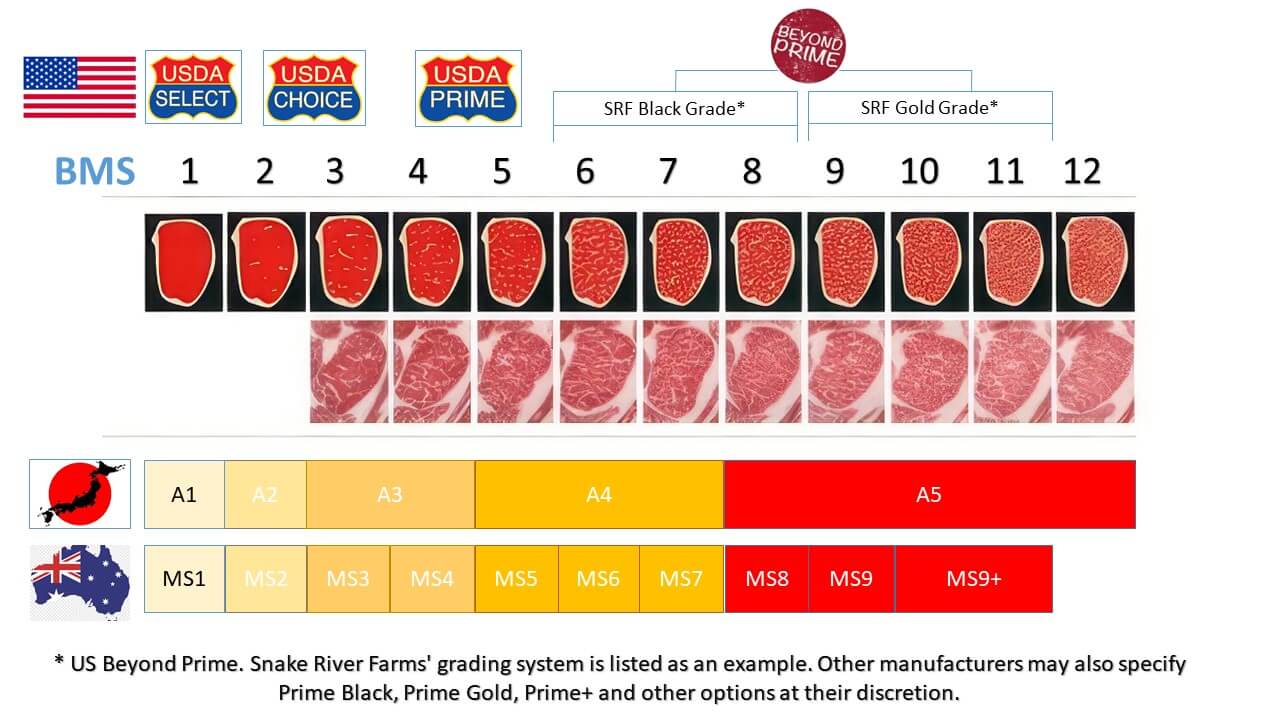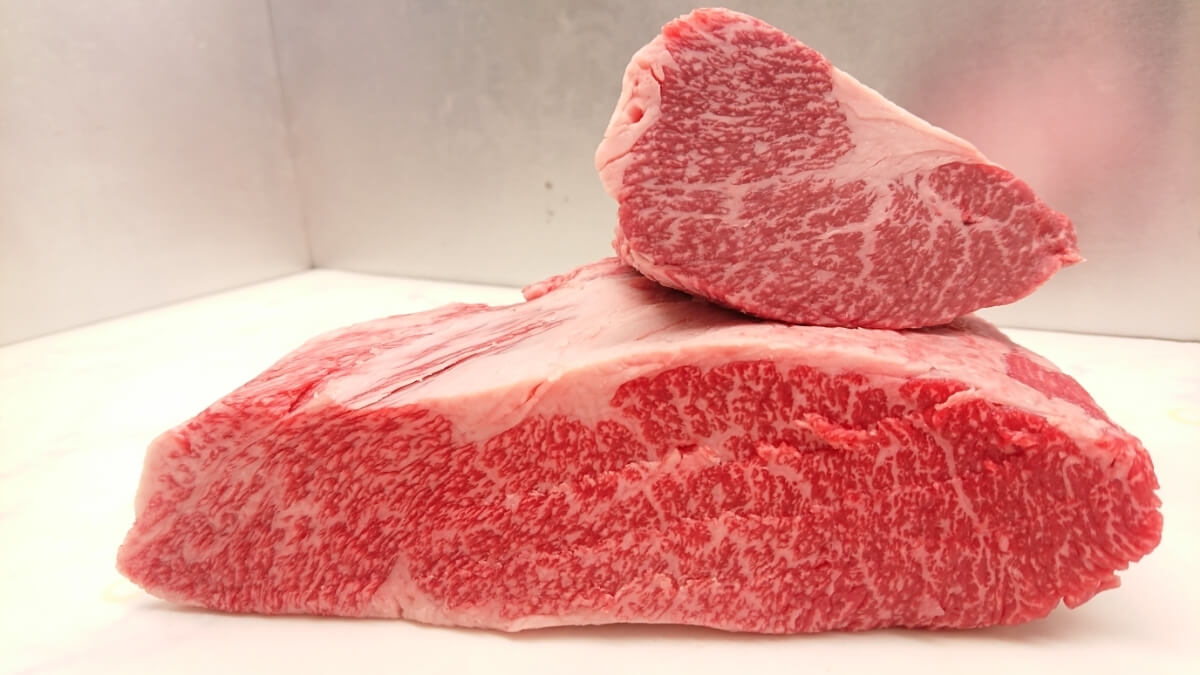This article talks about the details of wagyu grading. It’s how we tell wagyu apart from other meats. The system shows the care and high standards put into producing Wagyu beef.
Wagyu beef grades are more than just labels. They make sure quality and great taste. With these grades, we celebrate the best beef. We look at how much marbling, color, and quality it has.
Japaneese Wagyu Grading System

The Japanese Wagyu grading system is a renowned benchmark in assessing the quality of Wagyu beef. It employs a rigorous two-pronged approach, including yield grade and meat quality grade, both crucial in determining the overall Wagyu beef grades.
The yield grade, symbolized by alphabets A to C, evaluates the proportion of consumable meat from the entire carcass weight. The ‘A’ yield grade symbolizes the highest yield, denoting a larger percentage of top-quality meat.

Simply put, beef quality grading looks at different aspects. This is done with a 1 to 5 scale. It considers three main factors: Beef Marbling Standard (BMS), Beef Color Standard (BCS), and Beef Fat Standard (BFS).
The BMS measures the fat inside the muscle, also known as marbling. On a scale from 1 to 12, a higher score means more marbling. Wagyu beef is known for its great amount of marbling, which gives it a superb flavor and tenderness. That’s what makes Wagyu premium beef!
The BCS and BFS are also important for Wagyu grading. The BCS score determines the meat’s color and brightness on a 1 to 7 scale. High scores on the BCS means the meat is fresher and better quality.
The BFS takes into account the fat’s color, shine, and quality. It also uses a scale from 1 to 7. High scoring BFS fat is healthier and more tasty, making the beef tastier overall.

The combination of the yield and quality grades provides the final Wagyu beef grades, with A5 being the zenith of Wagyu quality. Celebrated for its extraordinary marbling, vibrant color, and quality fat, A5 Wagyu beef offers a truly unparalleled gastronomic experience.
Understanding the American Wagyu Grading

The U.S. Department of Agriculture (USDA) grades all beef in America, including Wagyu. They look at two main things: how old the beef is and how much fat streaking it has.
- Age: This means how old the animal was when it was butchered. The age affects how tender the meat is. The USDA uses a letter system from A to E to say how old the beef is. ‘A’ means it’s very young and usually the most tender, ‘E’ means it’s the oldest and often tougher.
- Fat Streaking: This is also called marbling. It’s the lines of fat you see in the meat that look like marble. Marbling helps decide how good the beef is, because it affects the taste, feel, and how juicy the meat is. The USDA grades marbling from “Practically Devoid” to “Abundant”. More marbling means richer flavor, higher tenderness, and juicy beef.
The best quality Wagyu beef is given the “USDA Prime” label, because it has lots of marbling.
Still, the USDA has other grades below “Prime”, like “Choice” and “Select”.
“USDA Choice” is a step down from “Prime”. It has less marbling, but is still good quality. It might be a little less tender and tasty than Prime. The next grade is “USDA Select”, which has even less marbling. Select beef is usually leaner and might not be as juicy or flavorful as beef with more marbling.

Many American Wagyu ranchers exceed the standards set by the United States Department of Agriculture (USDA). Special focus is placed on the quality of marbling within the meat, which is a key indicator. Highly valued cuts of beef from American Wagyu frequently obtain designations like “Prime+”, “Ultra Prime” or “Prime Gold” to underscore their exceptional quality and set them apart from standard grades. These names reflect the superiority of the beef and adherence to the highest criteria. In truth, these meats can meet the lofty Japanese Wagyu requirements of A4 and A5.
Essentially, the American Wagyu grading system and the resulting Wagyu beef classifications serve as important reference points for shoppers and chefs. These ranks provide a trustworthy measure of the standard, taste capacity, and cooking value of the meat being acquired. The scores help determine traits like marbling level and fat distribution that influence tenderness, juiciness and flavor. No matter the rating, all Wagyu cattle are known for producing exceptionally creamy, smooth beef thanks to its high marbling. While rank alone doesn’t guarantee a perfect cut, it offers transparency so people can confidently select cuts aligned with their preferences.
Introduction to the Australian Wagyu Beef Grades

Japan’s grading system for Wagyu beef is globally accepted, but Australia’s system is also influential. This system focuses on two main things: how much marbling the meat has and its color. Both are important to the final Wagyu grade.
Marbling score is a key part of Australia’s Wagyu grading system. It’s a scale from 0 to 9+, with a high score showing lots of marbling in the meat. This score looks at how much marbling there is and where it’s found in the meat. This can change how the beef feels and tastes. For example, top-notch Wagyu beef usually has a high marbling score. This means there’s a lot of marbling that makes eating it a unique experience.
But it’s not all about marbling. The color of the meat also matters in Australia’s Wagyu grading system. They judge this on a 1 to 7 scale, with high scores for meat that’s richer and more even in color. The color can tell us how fresh and good the beef is. More colorful meat is usually fresher and better.
In the Australian Wagyu grading system, you often see combined ratings like Marble Score 9+ or 7-8. These scores give you a thorough evaluation of the Wagyu beef’s quality. This system ensures each Wagyu beef cut is top quality, promising an impressive meal for Wagyu beef lovers everywhere.
Differences Between Grading Systems: Japan, Australia, and America

Wagyu beef is graded differently in Japan, Australia, and America. Each system uses its own factors to determine the quality of the beef. All consider marbling, but they don’t focus on the same factors.
The Japanese system is detailed. It looks at yield, meat quality, marbling, meat color, firmness, and fat quality. An A5 grade means the best Wagyu beef.
In Australia, the system mostly examines marbling and meat color. A Marble Score of 9+ suggests top-notch Wagyu beef.
The American system is easy to understand. It values marbling and the age of the animal. The best grade, USDA Prime, is given to beef with the most marbling.
Keep in mind, these different systems can affect the quality of Wagyu beef. A Japanese A5 grade might not equal a USDA Prime grade in America because they have different criteria and scales.
| Criteria | Japanese System | Australian System | American System |
| Administering Body | Japanese Meat Grading Association | Meat and Livestock Australia | United States Department of Agriculture |
| Grading Factors | Yield grade (A to C), meat quality grade (1 to 5) including marbling, meat color and brightness, firmness and texture, and fat quality | Marbling score (0 to 9+), meat color (1 to 7) | Maturity (A to E), marbling (Practically Devoid to Abundant) |
| Emphasis | Both yield and quality, with a strong focus on marbling | Primarily on marbling and meat color | Marbling and maturity of the animal |
| Highest Grade | A5 | Marble Score 9+ | USDA Prime |
| Quality Indication | A5 represents the highest yield and meat quality, including superior marbling | Higher Marble Scores indicate superior marbling and quality | USDA Prime indicates the highest degree of marbling and tenderness |
Conclusion
Wagyu beef grades might seem tricky, but they’re worth understanding. They make us value Wagyu even more. Regions like Japan use A5 grading, Australia uses Marble Scores, and the U.S. focuses on age and marbling. Each method offers a different viewpoint on Wagyu’s quality and taste. Knowing about this isn’t for nerd points, it helps you choose the best beef and understand what makes Wagyu stand out.
Wagyu grading might seem much at first, but think of it as a handy guide. It’s your roadmap to exploring Wagyu country. It shows the commitment that sets Wagyu apart in the top-shelf food world. So next time you’re digging into a Wagyu steak, think about its adventure. From field to grading to your fork, every grade tells a tale of top-notch beef.
References
- Japanese Meat Grading Association. (n.d.). Beef Grading http://www.jmi.or.jp/en/info/index2.html
- Meat & Livestock Australia. (n.d.). Australian Beef Carcase Grading. https://www.mla.com.au/
- United States Department of Agriculture. (n.d.). USDA Beef Quality and Yield Grades. https://www.ams.usda.gov/grades-standards/beef
- Wagyu International. (n.d.). Meat Grading. https://www.wagyuinternational.com/
